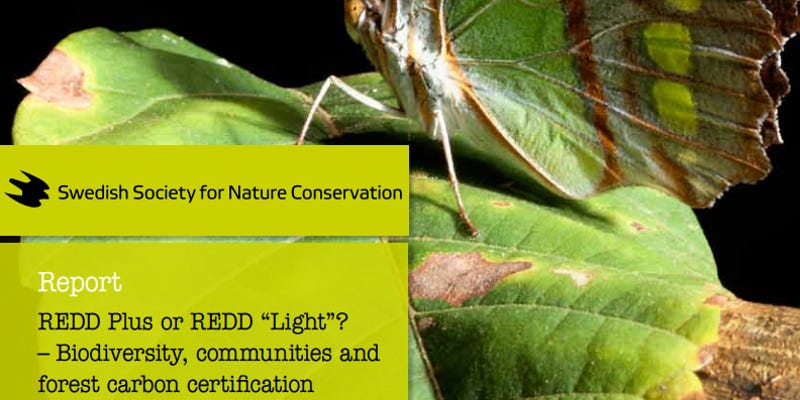Until there is an agreement at the UNFCCC level on REDD, carbon credits from REDD projects can only be traded on voluntary markets. Buyers of these carbon credits rely on independent certification schemes to tell the difference between “real” carbon credits and “cowboy” carbon credits.
The Verified Carbon Standard (VCS) focusses on carbon accounting. VCS “verifies” the project developer’s calculations about how many carbon offsets are created by the project, or how many tons of carbon would have been emitted to the atmosphere in the absence of the project. Or, as Dan Welch put it, verifying, “an imaginary commodity created by deducting what you hope happens from what you guess would have happened”.
A second question is whether the REDD project brings benefits to the communities living in and near the project area. The Climate Community and Biodiversity Standards (CCB) focus on environmental and social aspects of forestry offset projects.
The Swedish Society for Nature Conservation (SSNC) recently released a report that looks at four case studies and asks whether CCB certification really ensures that projects deliver community and biodiversity benefits. The report, titled, “REDD Plus or REDD ‘Light’? Biodiversity, communities and forest carbon certification”, was written by Göran Eklöf of Context.
Eklöf looks at how the CCB standard was applied in three REDD projects: Oddar Meanchey in Cambodia, Ulu Masen in Indonesia, and Kasigau Corridor in Kenya, and one tree planting project in the Kikonda Forest Reserve in Uganda.
SSNC’s report looks at several issues that are key to REDD: Land tenure; Free, prior and informed consent; Benefit sharing; Biodiversity; and Carbon. Eklöf found numerous problems and concluded that CCB certification does not provide a guarantee that certified projects are benefiting either communities or biodiversity:
CCB certification can thus not be seen as assurance that communities benefit from the projects, tenure rights are respected, or that FPIC has been ensured. CCB requirements on biodiversity are also of little relevance for REDD type projects.
REDD-Monitor asked Eklöf a few questions about the report:
REDD-Monitor: What sort of problems did you find with the REDD projects that you visited?
Göran Eklöf: The problems vary greatly between the projects depending on the local and national context, the character of the project proponents, and the phase that the project was in when I visited. The Ulu Masen project in Indonesia appears to have failed completely due to the irresponsible actions of one project proponent, and a lack of interest on behalf of the new provincial government. It was the first project ever to be certified by the CCB, but it has never been implemented on the ground.
And in Cambodia, I saw massive encroachments in the project area by government soldiers, on a scale that endangers the viability of the community forests that make up the Oddar Meanchey project. The Government of Cambodia is the project holder through the Forestry Administration, but apparently lacks any ambition to redirect the new settlements.
A more general problem is the lack of proper consultations with local communities, and insufficient processes for ensuring their free and prior informed consent (FPIC), as required by the current version of the CCB standard. The CCB standard does not provide any guidance on what constitutes an acceptable process. A proper mechanism for the sharing of revenues from the sale of carbon credits is only in place in one of the projects, but auditors have certified that consent has been given even in projects where the terms are still to be negotiated. And although the Standard makes reference to “equitable sharing of benefits”, this is not included in the criteria against which projects are assessed, and there is no guidance as to what it means.
REDD-Monitor: Does CCB certification at least ensure that biodiversity is conserved?
Göran Eklöf: The CCB standard claims to certify “best practices to generate significant benefits” for biodiversity. But it is difficult to even imagine a project that actually reduces deforestation but does not meet the basic requirement, which is only to create net positive impacts for biodiversity compared to a baseline scenario where deforestation is allowed to continue. Even the Gold Standard level of certification does not require any proactive management of biodiversity.
REDD-Monitor: What was the most important finding from your research for the report?
Göran Eklöf: The application of the CCB standard appears to be inconsistent and weak. There seems to be a strong inclination among the accredited auditors towards approval, even in cases where the information they present themselves clearly indicates that the standard requirements have not been met.






Interesting read. I believe these points were all raised in "Redeeming REDD: policies, incentives and social feasibility" (2013) in a book I wrote that was published by earthscan/Taylor & Francis. Am working on a sequel to that one now focused on NbS and climate mitigation across the global south.
Comments following the original post on REDD-Monitor.org are archived here: https://archive.ph/12VEd#selection-345.1-345.12